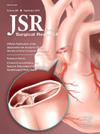评估选择III级钝性脾损伤非重症监护病房入住的安全性
IF 1.7
3区 医学
Q2 SURGERY
引用次数: 0
摘要
III级钝性脾损伤(bsi)患者可能需要脾切除术。目前,这些患者进入重症监护病房(ICU)或非ICU楼层的实践存在差异。我们假设选择的BSI患者可以入住非icu位置,而不会增加并发症、死亡或需要脾切除术。方法查询2017-2019年创伤质量改善计划数据库中非老年成人(18-64岁)III级脑损伤。排除低血压、心率>;90、呼吸率>;22、头部/脊柱/胸部/上肢或下肢简易损伤量表>;2,或肝硬化、中风、心肌梗死或慢性阻塞性肺疾病患者,否则这些患者可能需要进入ICU。将ICU住院患者与非ICU住院患者进行比较。对死亡率进行多变量logistic回归。结果1899例患者中有1000例(52.7%)入住ICU。队列之间的人口统计数据相似(所有P >;0.05)。ICU组结肠损伤发生率较高(0.9%对0%,P = 0.004)。ICU住院患者脾切除术发生率增加(4.8%比2.0%,P <;0.001),主要并发症(1.8% vs 0.6%, P = 0.013)和住院时间(4.0 vs 3.0, P <;0.001)。然而,队列之间的死亡率(0.3%对0.4%,P = 0.60)或相关的死亡风险(优势比0.68,置信区间0.152-3.070,P = 0.62)没有差异。结论脾切除术、并发症和死亡率总体上较低,与非icu病房收治的几乎隔离的III级BSI患者相似或更好。这表明有成人III级BSI人群可以避免进入ICU。本文章由计算机程序翻译,如有差异,请以英文原文为准。
Assessing the Safety of Nonintensive Care Unit Admission for Select Grade III Blunt Splenic Trauma
Introduction
Patients with grade III blunt splenic injuries (BSIs) may require splenectomy. Currently, there is practice variation for admission of these patients to an intensive care unit (ICU) or non-ICU floor. We hypothesized that select BSI patients may be admitted to non-ICU locations without increased complications, death, or need for splenectomy.
Methods
The 2017-2019 Trauma Quality Improvement Program database was queried for non-elderly adult (18-64 y-old) grade III BSIs. Patients with hypotension, heart rate >90, respiratory rate >22, abbreviated injury scale for the head/spine/thorax/upper or lower extremity >2, or with cirrhosis, stroke, myocardial infarction, or chronic obstructive pulmonary disease were excluded as these patients might otherwise warrant ICU admission. ICU admissions were compared to non-ICU admissions. Multivariable logistic regression for mortality was performed.
Results
From 1899 patients included, 1000 (52.7%) were admitted to the ICU. There was similar demographics between cohorts (all P > 0.05). There was a higher rate of colon injury in the ICU cohort (0.9% versus 0%, P = 0.004). ICU admissions had increased rates of splenectomy (4.8% versus 2.0%, P < 0.001), major complications (1.8% versus 0.6%, P = 0.013) and length of stay (4.0 versus 3.0, P < 0.001). However, there was no difference in the rate (0.3% versus 0.4%, P = 0.60) or associated risk of mortality (odds ratio 0.68, confidence interval 0.152-3.070, P = 0.62) between cohorts.
Conclusions
The rate of splenectomy, complications, and mortality was low overall and similar or better for nearly isolated grade III BSI patients admitted to non-ICU floors. This suggests there is a population of adult grade III BSI that can avoid ICU admission.
求助全文
通过发布文献求助,成功后即可免费获取论文全文。
去求助
来源期刊
CiteScore
3.90
自引率
4.50%
发文量
627
审稿时长
138 days
期刊介绍:
The Journal of Surgical Research: Clinical and Laboratory Investigation publishes original articles concerned with clinical and laboratory investigations relevant to surgical practice and teaching. The journal emphasizes reports of clinical investigations or fundamental research bearing directly on surgical management that will be of general interest to a broad range of surgeons and surgical researchers. The articles presented need not have been the products of surgeons or of surgical laboratories.
The Journal of Surgical Research also features review articles and special articles relating to educational, research, or social issues of interest to the academic surgical community.

 求助内容:
求助内容: 应助结果提醒方式:
应助结果提醒方式:


